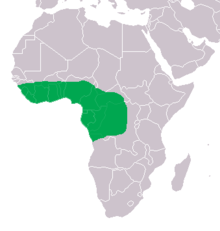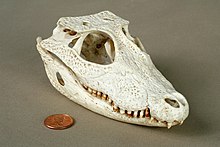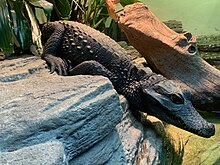| Dwarf crocodile Temporal range: Miocene - Recent, 11.6–0 Ma PreꞒ Ꞓ O S D C P T J K Pg N | |
|---|---|

| |
| At Dorée Tropical Aquarium | |
| Conservation status | |
 Vulnerable (IUCN 2.3) | |
| CITES Appendix I (CITES) | |
| Scientific classification | |
| Domain: | Eukaryota |
| Kingdom: | Animalia |
| Phylum: | Chordata |
| Class: | Reptilia |
| Clade: | Archosauromorpha |
| Clade: | Archosauriformes |
| Order: | Crocodilia |
| Family: | Crocodylidae |
| Subfamily: | Osteolaeminae |
| Genus: | Osteolaemus |
| Species: | O. tetraspis |
| Binomial name | |
| Osteolaemus tetraspis Cope, 1861 | |

| |
| Range of the dwarf crocodile in green | |
The dwarf crocodile (Osteolaemus tetraspis), also known as the African dwarf crocodile, broad-snouted crocodile (a name more often used for the Asian mugger crocodile) or bony crocodile, is an African crocodile that is also the smallest extant (living) species of crocodile.
Description


Dwarf crocodiles attain a medium adult length of 1.5 m (4.9 ft), though the maximum recorded length for this species is 1.9 m (6.2 ft). Adult specimens typically weigh between 18 and 32 kg (40 and 71 lb), with the largest females weighing up to 40 kg (88 lb) and the largest males weighing 80 kg (180 lb). This makes it the smallest living crocodile species, although the Cuvier's dwarf caiman (Paleosuchus palpebrosus), a member of the family Alligatoridae, is smaller at up to about 1.7 m (5.6 ft). If the Congo dwarf crocodile (O. osborni) is recognized as a valid species, it would be both the smallest crocodile and the smallest crocodilian since it does not surpass 1.2 m (3.9 ft). Adults are all dark above and on their sides, while the underside is yellowish with black patches.
Some individuals living in the caves of Abanda, Gabon, displayed orange patches, apparently due to alkaline bat guano that erodes the skin of the crocodile. Juveniles have a lighter brown banding on body and tails and yellow patterns on the head.
As a result of its small size and heightened vulnerability to predation, this species of crocodile has a heavily armoured neck, back, and tail and also has osteoderms on its belly and underside of neck.
Osteolaemus has a blunt short snout, as long as it is wide, similar to that of a Cuvier's dwarf caiman, probably a result of occupying a similar ecological niche. The dentition consists of four premaxillary teeth, 12 to 13 on the maxilla, and 14 to 15 on the dentary bone.
O. t. tetraspis has lighter colours, a more pointed, upturned snout, and more body armour than O. t. osborni.
Distribution and habitat
Dwarf crocodiles range across tropical regions of Sub-Saharan West Africa and Central Africa. Such a distribution greatly overlaps with that of the slender-snouted crocodile, encompassing countries as far west as Senegal, reaching Uganda in the east, and ranging as southerly as Angola. The last confirmed record from Uganda was in the 1940s, but whether the species, which is easily overlooked, still survives there is unclear (it was always marginal in this country, only occurring in the far southwest).
Dwarf crocodiles live from lowlands to mid-altitude in streams, small rivers, swamps, pools and mangrove, but generally avoid main sections of large rivers. Most of their range is within forested regions, but it may extend into more open regions where the streams or river are well-shaded. They are also found in seasonally-flooded forest. Unlike most crocodiles, dwarf crocodiles only rarely bask in the sun. During the night they may move some distance from water on land. Reports exist of dwarf crocodiles in isolated pools in the savannah. Dwarf crocodiles living long-term in caves are known from western Gabon, which stand out as an isolated genetic group.
Biology and behaviour


The dwarf crocodile is a timid and mainly nocturnal reptile that spends the day hidden in pools or burrows, although it occasionally may be active during the day. Foraging is mainly done in or near the water, although it is considered to be one of the most terrestrial species of crocodilian and may expand the feeding pattern to land in extensive forays, especially after rains.
Dwarf crocodiles are generalist predators and have been recorded feeding on a wide range of small animals such as fish, crabs, frogs, gastropods, insects, lizards, water birds, bats and shrews.
In a study in the Democratic Republic of the Congo the primary food item was fish, and in a study in Nigeria the primary food items were gastropods and crabs. In the Congo there is a level of seasonality in its diet, changing from fish in the wet season to crustaceans in the dry season, when fish are less available. Plant material has also been found in the stomach of dwarf crocodiles, but it is suspected that this is ingested by accident. They can survive for relatively long periods without food. During the dry season, dwarf crocodiles often retreat to deep holes.

True to its solitary, nocturnal nature, a dwarf crocodile digs out a burrow in which to hide and rest during the day, which can sometimes have a submerged entrance. An individual lacking the right conditions to do so usually lives between tree roots that hang over the ponds where it lives.
Reproduction
Interacting closely only in breeding season, female dwarf crocodiles build their nest mounds at the beginning of the wet season, which spans May and June. The nest, situated near the water, is a mound of wet, decaying vegetation that incubates the eggs due to the heat generated by the decomposition of the plant material. A small number of eggs is laid, usually about 10, though in extreme cases up to 20, and they incubate in 85 to 105 days. Hatchlings measure 28 cm when emerging from the eggs. The female guards the nest during the incubation period, and after the eggs hatch, she watches over the young for an unknown period of time, as young can be eaten by a great range of predators (birds, fish, mammals and reptiles, including other crocodiles).
Taxonomy and etymology
The second species has had a somewhat convoluted taxonomical history. It was first described as Osteoblepharon osborni by Schmidt in 1919, based on a few specimens from the Upper Congo River Basin in what is now the Democratic Republic of Congo. However, Inger in a 1948 paper found the specimens wanting of characteristics that would justify a generic separation from Osteolaemus and referred the specimens to Osteolaemus osborni. In 1961, it was reduced to subspecies rank.
A study of morphology published in 2007, and studies of DNA in 2009, 2013 and 2015 indicate that three distinctly different populations of Osteolaemus may merit full species recognition. These are O. tetraspis (Central Africa, except the Congo River Basin), O. osborni (Congo River Basin), and a third possibly unnamed species (West Africa). Uncertainty exists for the population in Nigeria (between O. tetraspis and the possibly unnamed West African species) as it has not been studied. A fourth clade was found in a study of captives in 2013, but where members of this clade live in the wild is unclear. In some regions the species may come into contact. For example, Cameroon is home to both O. tetraspis and O. osborni.
Etymology
The generic name, Osteolaemus, means "bony throat", and is derived from the Ancient Greek όστεον (bone) and λαιμός (throat). The genus was named as such due to the osteoderms found among the scales in the neck and belly.
The specific epithet, tetraspis, means "four shields", and derives from the Ancient Greek τετρα (four) and ασπίς (shield), as the back of the neck has four large, shield-like scales.
Phylogeny
A 2018 tip dating study by Lee & Yates simultaneously using morphological, molecular (DNA sequencing), and stratigraphic (fossil age) data established the inter-relationships within Crocodylidae. In 2021, Hekkala et al. were able to use paleogenomics, extracting DNA from the extinct Voay, to better establish the relationships within Crocodylidae, including the subfamilies Crocodylinae and Osteolaeminae.
The below cladogram shows the results of the latest study:
| Crocodylidae |
| ||||||||||||||||||||||||||||||||||||||||||||||||||||||||||||||||||||||||||||||||||||||||||||||||||||||||||||||||||||||||||||||||||||||||||||||||
| (crown group) |


Conservation
The dwarf crocodile is considered vulnerable by the IUCN, and it is listed on Appendix I of CITES. It is a little-known species, so unlike their more studied relatives, conservationists are often not as aware of how their populations are faring under the growing human pressure over the ecosystems where they abide. Survey data, when available, show some degree of decline, either by hunting for bushmeat or habitat loss due to deforestation. However, it is a widely spread, and presumably numerous overall. In some regions the populations remain healthy, but in others (such as Gambia and Liberia) it has seriously declined and may risk extirpation. Dwarf crocodiles occur in several protected reserves.
Though some skins are used in local manufacturing of leather products, they are of poor quality, so little interest is shown in captive breeding or a sustainable use program. In contrast, they are sometimes hunted for food and part of the bushmeat trade.
Dwarf crocodiles are widely kept and bred in zoos. Based on a study of individuals kept in AZA zoos, captives in North America are primarily O. tetrapis and the possibly unnamed West African species, but there are also some hybrids. Another study of individuals kept at EAZA zoos revealed a similar picture for Europe, but also that there were a few individuals of the fourth clade (native range in the wild unknown) and a single O. osborni.
Gallery
-
Tooth
- Bronx Zoo, USA
-
 Pittsburgh Zoo, USA
Pittsburgh Zoo, USA
-
 Cleveland Zoo, USA
Cleveland Zoo, USA
-
 Karlsruhe Zoo, Germany
Karlsruhe Zoo, Germany
-
 Karlsruhe Zoo, Germany
Karlsruhe Zoo, Germany
-
Berlin Zoological Garden, Germany
-
 Aquazoo Löbbecke Museum, Germany
Aquazoo Löbbecke Museum, Germany
-
 Tierpark Hellabrunn, Germany
Tierpark Hellabrunn, Germany
-
Tierpark Dählhölzli, Switzerland
-
 Bristol Zoo, UK
Bristol Zoo, UK
-
 Bioparc in Fuengirola, Spain
Bioparc in Fuengirola, Spain
-
 Wildlands Adventure Zoo, Netherlands
Wildlands Adventure Zoo, Netherlands
-
 Reptilarium du Larzac, France
Reptilarium du Larzac, France
-
 5 year old female, at Micro Zoo de Saint Malo, France
5 year old female, at Micro Zoo de Saint Malo, France
-
 5 year old female, at Micro Zoo de Saint Malo, France
5 year old female, at Micro Zoo de Saint Malo, France
-

-

References
- Rio, Jonathan P.; Mannion, Philip D. (6 September 2021). "Phylogenetic analysis of a new morphological dataset elucidates the evolutionary history of Crocodylia and resolves the long-standing gharial problem". PeerJ. 9: e12094. doi:10.7717/peerj.12094. PMC 8428266. PMID 34567843.
- ^ Crocodile Specialist Group (1996). "Osteolaemus tetraspis". IUCN Red List of Threatened Species. 1996: e.T15635A4931429. doi:10.2305/IUCN.UK.1996.RLTS.T15635A4931429.en. Retrieved 19 November 2021.
- "Appendices | CITES". cites.org. Retrieved 2022-01-14.
- Osteolaemus tetraspis at the Reptarium.cz Reptile Database. Accessed 17 September 2018.
- "Osteolaemus tetraspis (Cope, 1861)". crocodilian.com. Archived from the original on 21 February 2020. Retrieved 23 September 2019.
- "Dwarf Crocodile". The Animal Files. Retrieved 7 August 2017.
- ^ "The African Dwarf Crocodile". h2g2. 1 June 2010. Retrieved 7 August 2017.
- Britton, Adam. "Paleosuchus". Crocodilians: Natural History & Conservation. Crocodilian.com. Retrieved 9 August 2017.
- ^ Sprawls, S.; K. Howell; R. Drewes & J. Ashe (2002). A Field Guide to the Reptiles of East Africa. Academic. pp. 276–277. ISBN 978-0-12-656470-9.
- ^ "Osteolaemus tetraspis". crocodilian.com. 1 June 2010. Retrieved 9 August 2017.
- Shirley, Matthew; Burtner, Brittany; Oslisly, Richard; Sebag, David; Testa, Olivier (2016-09-26). "Diet and body condition of cave-dwelling dwarf crocodiles (Osteolaemus tetraspis , Cope 1861) in Gabon". African Journal of Ecology. 55 (4): 411–422. doi:10.1111/aje.12365.
- ^ Pauwels; Barr; Sanchez & Burger (2007). "Diet records for the Dwarf Crocodile, Osteolaemus tetraspis tetraspis in Rabi Oil fields and Loango National Park, southwestern Gabon". Hamadryad. 31 (2): 258–264.
- Eaton, M. J., Martin, A. P., Thorbjarnarson, J. B., & Amato, G. (2009). Species-level diversification of African dwarf crocodiles (Genus Osteolaemus): A geographic and phylogenetic perspective. Molecular Phylogenetics and Evolution, 50(3), 496–506. https://doi.org/10.1016/j.ympev.2008.11.009
- ^ Eaton, M.J. (2010). "Dwarf crocodile Osteolaemus tetraspis" (PDF). In Manolis, S.C.; C. Stevenson (eds.). Crocodiles: Status, Survey and Conservation Action Plan (3 ed.). IUCN Crocodile Specialist Conservation Group. pp. 127–132.
- ^ "Weird orange crocodiles found gorging on bats in Gabon's caves". New Scientist. 12 October 2016. Retrieved 10 August 2017.
- Hance, Jeremy (2018-01-29). "Orange cave crocodiles may be mutating into new species". the Guardian. Retrieved 2018-01-29.
- Luiselli, L.; Akani, G. C. & Capizzi, D. (1999). "Is there any interspecific competition between dwarf crocodiles (Osteolaemus tetraspis) and Nile monitors (Varanus niloticus ornatus) in the swamps of central Africa? A study from south-eastern Nigeria". Journal of Zoology. 247 (1): 127–131. doi:10.1111/j.1469-7998.1999.tb00200.x.
- Wermuth, H. & R. Mertens (1961). Schildkröten, Krokodile, Brückenechsen. Veb Gustav Fischer Verlag.
- Brochu, C.A. (2007). "Morphology, relationships, and biogeographical significance of an extinct horned crocodile (Crocodylia, Crocodylidae) from the Quaternary of Madagascar". Zoological Journal of the Linnean Society. 150 (4): 835–863. doi:10.1111/j.1096-3642.2007.00315.x.
- ^ Eaton, Mitchell J.; Andrew Martin; John Thorbjarnarson & George Amato (March 2009). "Species-level diversification of African dwarf crocodiles (genus Osteolaemus): A geographic and phylogenetic perspective". Molecular Phylogenetics and Evolution. 50 (3): 496–506. doi:10.1016/j.ympev.2008.11.009. PMID 19056500.
- ^ Franke, Franziska Anni; Schmidt, Fabian; Borgwardt, Christin; Bernhard, Detlef; Bleidorn, Christoph; Engelmann, Wolf-Eberhard & Schlegel, Martin (2013). "Genetic differentiation of the African dwarf crocodile Osteolaemus tetraspis Cope, 1861 (Crocodylia: Crocodylidae) and consequences for European zoos". Organisms Diversity & Evolution. 13 (2): 255–266. doi:10.1007/s13127-012-0107-1. S2CID 14636510.
- ^ Shirley, M. H.; Villanova, V. L.; Vliet, K. A. & Austin, J. D. (2015). "Genetic barcoding facilitates captive and wild management of three cryptic African crocodile species complexes". Animal Conservation. 18 (4): 322–330. Bibcode:2015AnCon..18..322S. doi:10.1111/acv.12176. S2CID 82155811.
- Smolensky, N.L. (2015). "Co-occurring cryptic species pose challenges for conservation: a case study of the African dwarf crocodile (Osteolaemus spp.) in Cameroon". Oryx. 49 (4): 584–590. doi:10.1017/S0030605314000647.
- Michael S. Y. Lee; Adam M. Yates (27 June 2018). "Tip-dating and homoplasy: reconciling the shallow molecular divergences of modern gharials with their long fossil". Proceedings of the Royal Society B. 285 (1881). doi:10.1098/rspb.2018.1071. PMC 6030529. PMID 30051855.
- Hekkala, E.; Gatesy, J.; Narechania, A.; Meredith, R.; Russello, M.; Aardema, M. L.; Jensen, E.; Montanari, S.; Brochu, C.; Norell, M.; Amato, G. (2021-04-27). "Paleogenomics illuminates the evolutionary history of the extinct Holocene "horned" crocodile of Madagascar, Voay robustus". Communications Biology. 4 (1): 505. doi:10.1038/s42003-021-02017-0. ISSN 2399-3642. PMC 8079395. PMID 33907305.
Further reading
- "Dwarf crocodile". The Encyclopedia of Life.
- Osteolaemus tetraspis@Crocodilian Species List
- Osteolaemus tetraspis@Crocodile Status Survey and Conservation Action Plan - Second Edition
| Extant Crocodilian species | |||||||||||||||||
|---|---|---|---|---|---|---|---|---|---|---|---|---|---|---|---|---|---|
| |||||||||||||||||
| |||||||||||||||||
| |||||||||||||||||
| Related articles on alligators, caimans, crocodiles and gharials | |
|---|---|
| Topics | |
| Human interaction | |
| Taxon identifiers | |
|---|---|
| Osteolaemus tetraspis |
|